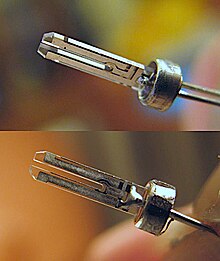Watch quartz
A clock quartz is a special oscillating quartz that is used as a clock in quartz and real-time clocks, among other things . Its frequency is 32.768 kHz = 32 768 Hz = 2 15 Hz (in the standardized notation of numbers for Germany and Austria ). It is designed in the form of a miniaturized tuning fork and built into a cylindrical housing (diameter typ. 2… 3 mm) with wire connections or into a cuboid SMD module.
General
Due to their special shape, clock crystals vibrate at a comparatively very low basic frequency. The power consumption of electronic circuits in widespread CMOS semiconductor technology increases with increasing clock frequency. By choosing a low frequency, particularly energy-saving quartz oscillators with battery supply can be implemented, as are common in clock systems and quartz watches. The power consumption of a clock crystal is a maximum of 1 μW. The Pierce circuit is usually used as the oscillator circuit for clock crystals .
The frequency of a clock quartz is also fixed because of its easy divisibility in order to be able to derive the second pulse , which is essential for clock systems . Halving a frequency is possible with little effort in terms of circuitry by means of a T flip-flop . A series connection of 15 T flip-flops can generate the frequency of 1 Hz from the quartz frequency of 2 15 Hz, which is used in electro-mechanical quartz watches to control the Lavet stepper motor .
Clock crystals are designed in X or XY quartz cut . The tuning fork is formed mechanically from the quartz by sawing or by means of etching techniques. The metallic electrodes , which are connected to the external connections, are vapor-deposited onto the prongs .
The relative limit deviation at the reference temperature of 25 ° C is unusually small for a consumer article and is in the range of 20 ppm . The same relative limit deviation also applies to the divided frequency and the period of the second pulse. The influence of temperature on the frequency by a parable given
with a parabola constant , which for clock crystals is in the range of 0.04 ppm / ° C 2 . The influence is particularly small in the vicinity of the reference temperature . A deviation of ± 5 ° C results in a frequency deviation of –1 ppm.
literature
- Bernd Neubig, Wolfgang Briese: The large quartz cookbook . Franzis', Feldkirchen 1997, ISBN 3-7723-5853-5 ( qsl.net ).
Individual evidence
- ^ Elmar Schrüfer, Leonhard M. Reindl, Bernhard Zagar: Electrical measurement technology: Measurement of electrical and non-electrical quantities. Hanser, 11th edition, 2014, p. 326
- ↑ Joachim Heintze: Textbook on Experimental Physics, Volume 3: Electricity and Magnetism. Springer, 2016, p. 60
- ↑ a b c Technical data sheet SXCT2-S. SMD watch quartz. Archived from the original on February 18, 2018 ; accessed on September 3, 2010 (PDF; 65 kB).
- ↑ a b c Technical data sheet MH32768C / L. Cylindrical clock quartz. Archived from the original on April 12, 2019 ; accessed on February 17, 2018 .




